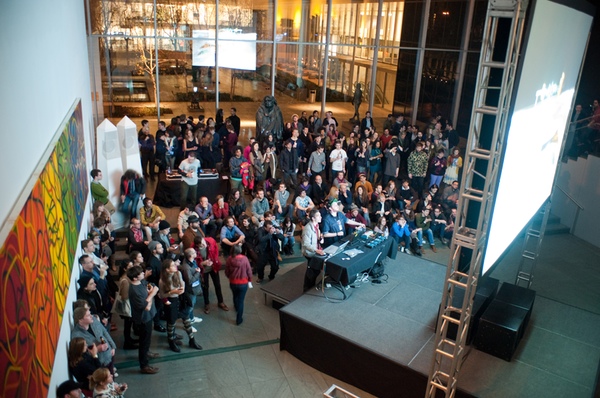
Photos by Kristy Leibowitz/elkstudios
This past weekend, MoMA presented a collaboration between electronic musician Daniel Lopatin—who records under the moniker Oneohtrix Point Never—and video artist Nate Boyce, as part of its PopRally series of art parties. While not an overly serious gathering, Boyce and Lopatin delivered an hour of strobing, structuralist-minded imagery over relentless digital throbbing. Each of the work’s sections was based upon a specific object in the MoMA’s sculpture collection and the overarching title, Reliquary House, suggested a congratulatory pat on the back for the museum. PopRally events are more often than not thematically connected to what’s concurrently on MoMA’s walls, while in this case the institution’s history was the tie-in.

The video screen displayed 3-D renderings of modernist forms by Isamo Noguchi, David Smith, Jacob Epstein, and Anthony Caro, which gyrated in “impossible” landscapes evoking the Panopticon look of the music video to Nine Inch Nail’s “Down In It.” To clarify their intention, Lopatin began each movement with details of the image being projected—dates, dimensions, curatorial texts—dictated by robotic voices a la Siri and the Hitchhiker’s Guide to the Galaxy. Within the foreboding visual environment, these came off as provocations of a sort, which gave way to beds of digital glitches and rollicking bass oscillations, positing a bleak underbelly to the neutrality of the subject material. Boyce and Lopatin, who often communicate a sense of humor about the austerity of contemporary tools and approaches in their work, perplexed the droll audience, who perhaps expected Lopatin to perform the angelic synthesizer music indicative of his latest record, Replica. Boyce and Lopatin stood ground side-by-side, facing their laptops, but more often were caught gazing up at the video screen.
Lopatin’s other recent art project, a zine titled Cool Drool, was available to PopRally attendees upon entry. Its contents are mostly visual contributions from like-minded musicians—Laurel Halo, C. Spencer Yeh, Adam Forkner, and Dominick Fernow—but also a photo essay of gifted restaurant-chain credit cards by Cory Arcangel, and a writing on the Amiga Demo scene during the early 1990s by Derek Walmsley of The Wire. Walmsley’s description of the Demos—“vector graphics, bastard digital sound, primitive sampledelia, ray traced objects, rolling copper bars, metallic surfaces”— applied just as easily to Boyce and Loptatin’s Reliquary House.


Check out this video on YouTube:
http://www.youtube.com/watch?v=xmoApbjQKd4&feature=youtube_gdata_player
Sent from my iPhone
I'm a music lover and play in America - Have for 29 years …The thing that fascinates me is all the cultural differences that influence local music around the country - I hope that one day, all musicians can safely say that they stay off the sauce - wish I had, but it's things like this that saved me and brought me back to the real world of great music! http://www.medallionsaana.com/index.html